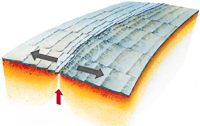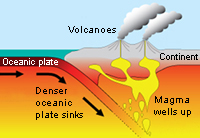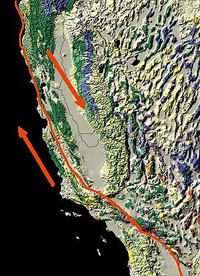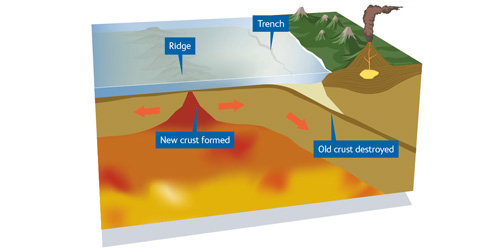Types of plate boundary
The interaction between plates at plate boundaries can be broadly divided into three categories: divergent,convergent or transform.

At a mid-ocean ridge, material from the asthenosphere rises up between separating tectonic plates and adds to their edges, causing them to grow. Based on a British Geological Survey diagram, with permission © NERC. All rights reserved.
Divergent boundaries
These occur when two plates slowly move apart. A new divergent boundary forms as a plume of hot magma rises from the lower mantle, stretching the continental crust above. Faults and fissures appear in the crust, allowing the magma below to well up in volcanic eruptions.
As the crust continues to stretch it sinks, forming a rift valley. Water floods in. Over a long period of time, this can lead to the creation of a new sea.
In about one million years, a large part of the Horn of Africa (Somalia, eastern Ethiopia, part of Djibouti and possibly some of Kenya) will split off from the rest of Africa to form a new island due to a rift that is expanding by about a centimetre a year.
A divergent boundary under the sea forms a mid-ocean ridge. As the plates separate, magma from the mantle wells up to form new crust so that the sea floor slowly spreads outwards from the ridge. The newly formed crust is less dense than the old crust. This causes it to rise up into a dramatic underwater mountain chain.
The mid-Atlantic ridge is a divergent boundary spreading at a rate of 2.5cm a year and, over the past 200 million years, has formed the Atlantic Ocean we know today.

Subduction. In this example, a plate that is under the ocean (left) is being subducted beneath part of a plate that is a continent (right). Based on a British Geological Survey diagram, with permission © NERC. All rights reserved.
Convergent boundaries
These occur when plates are pushed together and the denser plate sinks below the other in a process called subduction. The subducted plate is destroyed as it is pushed into the mantle.
Where oceanic plate meets continental plate the denser oceanic plate is subducted beneath the less-dense continental plate. A deep-sea trench is formed on the surface above where the plates meet. As the plates push past each other, slipping periodically, they cause earthquakes.
About 90 per cent of the world’s volcanoes form due to subduction. As a plate descends, it carries fluids with it, which are released into the mantle. These fluids lower the melting temperature of surrounding mantle rocks, which melt into magma. The magma rises up accumulating in magma chambers or reservoirs in the plate above, eventually erupting out of a chain of volcanoes on the surface.
Where two continental plates meet, the continental crust is too light for one to be pushed beneath the other into the denser mantle. Instead, the force crushes them together. Rocks are twisted and buckled, folded and squeezed. Eventually a mountain chain rises up.

The San Andreas fault occurs at a transform plate boundary.
Transform boundaries
At a transform boundary plates slide or, more accurately, grind past each other horizontally.
Transform boundaries also occur at mid-ocean ridges, as these are separated into segments, cut crossways by cracks where the rocks on either side move past, rather than away, from each other.
Strike-slip faults appear at transform boundaries, for example the San Andreas fault in California and the North Anatolian Fault in Turkey. Their jerky, thundering movement is enough to release earthquakes. Fortunately, most transform faults occur deep under the oceans, far away from people.
